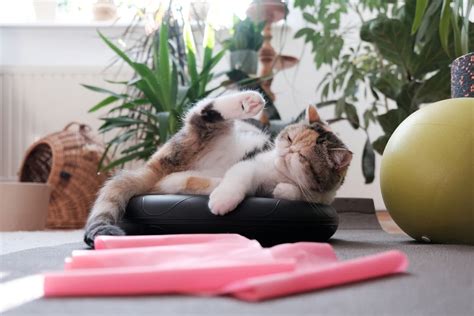Introduction
Cats are naturally active creatures that require regular exercise and fitness to maintain their health and well-being. However, in today’s modern society, many indoor cats are deprived of opportunities for movement and play, leading to health issues such as obesity, lethargy, and behavioral problems.

Why Feline Exercise Matters
- Obesity Prevention: Approximately 25-30% of cats in the United States are considered overweight or obese, putting them at risk for diabetes, heart disease, and other health issues. Exercise is crucial for weight management and maintaining a healthy body weight.
- Musculoskeletal Health: Exercise strengthens muscles, bones, and joints, improving mobility and reducing the risk of arthritis and other degenerative diseases related to physical inactivity.
- Behavioral Benefits: Exercise provides an outlet for cats’ natural hunting instincts and helps reduce boredom and stress. It can improve behavioral problems such as aggression, scratching, and inappropriate elimination.
- Socialization and Enrichment: Exercise can be a fun and interactive activity for both cats and their owners, fostering companionship and providing environmental enrichment.
Benefits of Feline Exercise
- Improved cardiovascular health
- Increased muscle mass and joint flexibility
- Reduced risk of obesity, diabetes, and heart disease
- Improved digestion and appetite regulation
- Enhanced mood and well-being
- Reduced stress, anxiety, and boredom
- Improved sleep quality and overall energy levels
Feline Exercise vs. Activity
It’s important to distinguish between exercise and activity. Activity refers to any movement a cat makes, such as walking, chasing, or pouncing. Exercise, on the other hand, is a structured and planned activity that provides a specific intensity and duration of physical exertion.
How Much Exercise Do Cats Need?
The American Association of Feline Practitioners (AAFP) recommends that adult cats get at least 30 minutes of daily exercise. This can be broken down into shorter sessions throughout the day, such as 10-15 minutes of playtime in the morning and afternoon. Kittens and senior cats may require less exercise, but they should still have opportunities for regular movement.
Types of Feline Exercise
There are various ways to provide exercise for your cat:
- Interactive Play: Engage your cat in games using toys such as wands, feathers, or laser pointers.
- Puzzle Toys: Use puzzle feeders or treat dispensers that require cats to work for their food, providing both mental and physical stimulation.
- Vertical Spaces: Provide cat trees, scratching posts, or shelves where cats can climb and jump, exercising their muscles and coordination.
- Cat Runs or Enclosures: If possible, consider building an enclosed area in your yard where your cat can safely explore and roam, getting plenty of exercise and fresh air.
Tips and Tricks
- Start Slowly: Gradually increase the intensity and duration of exercise over time to avoid injuries and discomfort.
- Make it Fun: Choose activities that your cat enjoys and finds engaging.
- Variety is Key: Offer a variety of exercise options to keep your cat interested and motivated.
- Supervise Play: Always supervise playtime with your cat, especially with young kittens or cats new to exercise.
- Reward Your Cat: Praise and treat your cat after exercise sessions to reinforce positive behavior and encourage them to continue exercising.
Reviews
- “My cat has lost weight and is much more active since we started our daily exercise routine.” – Sarah M.
- “Exercise has made a huge difference in my cat’s mood and behavior. He’s much more playful and affectionate now.” – Jennifer B.
- “I love seeing my cat enjoy himself while exercising. It’s a great way to bond and have fun together.” – David C.
- “As a veterinarian, I highly recommend regular exercise for all cats to maintain their health and well-being.” – Dr. James S.
Highlights
- Regular exercise is essential for the health and well-being of cats.
- Exercise can prevent obesity, improve physical and behavioral health, and provide mental stimulation.
- Cats need at least 30 minutes of exercise per day, which can be broken down into shorter sessions.
- Interactive play, puzzle toys, vertical spaces, and cat enclosures are effective ways to provide exercise for cats.
- Supervise play, start slowly, and provide variety to keep cats engaged and safe.
Conclusion
Incorporating exercise into your cat’s daily routine is crucial for their overall health and happiness. By following the tips and recommendations outlined in this article, you can help your feline friend live a longer, healthier, and more fulfilling life. Remember, exercise is not just about physical exertion; it’s about providing a holistically enriching environment where cats can thrive and express their natural instincts.





















